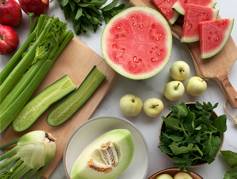Articles
Summer Soulstice: Rejuvenate in Nature
Summer is a juicer’s dream. The weather is warm, the sun is bright, and the local markets are bursting with fresh, colorful produce just waiting to be juiced or eaten right off the shelf. Peaches, we’re looking at you.
It’s the season for fun and sun, whether you are hosting a backyard barbecue, going for a long hike, or planning a road trip to visit family or friends, it’s the time of year to enjoy the outdoors.
Summer Rituals
The summer solstice is on June 21, and it’s the longest day of the year with the most sunlight. Half the year is behind us, and the other half is yet to come. The solstice is a wonderful time to celebrate the season and take a moment to set your goals for the rest of the year. The term “solstice” comes from two Latin words—sol (sun) and sistere (to stand still).
As the season changes from spring to summer, so can your rituals. Take some time to think about how you can take advantage of the sun. What small practices can you add to your day to enjoy your summer? Feel free to make a list of fun activities you’d like to partake in this summer.
Lillian Jacobs, a Los Angeles-based Ayurvedic health coach and yoga teacher, says she takes advantage of the summer sunshine by enjoying her meals outside.
“One of my easiest tips to increase your digestion and reduce uncomfortable symptoms like gas and bloat is to eat without distractions, which means moving away from screens,” she said. “I find that this is so much easier to do in the summertime when you can literally move away from all distractions and enjoy your meals in the fresh air.”
But she also cautions not to change your routine too drastically.
“I try to not shift my lifestyle too much as I move into summer,” Jacobs shared. “Ayurveda is big on routines to keep us healthy. Even as the days get longer, it's still important to get to bed around 10 p.m. in the evenings and stick to an early dinner (around 6 p.m.), when you can. The beauty of summer is that I can get outside for some fresh air and enjoy gentle movement after my dinner time.”
In fact, walking after dinner, or any meal, has many benefits, according to science. Researchers discovered that walking after a meal can help improve blood sugar control, according to a 2013 study.1 It doesn’t have to be one long walk either. Short, 15-minute walks after eating a meal showed better blood glucose improvements than those who took a single 45-minute walk in the morning.
Jacobs also makes small adjustments to her diet to enjoy summer, shifting away from winter foods such as soups, stews and baked goods to enjoying more seasonal fruit, steamed veggies, sprouts and summer salads. Juice ( of course) is another great way to take advantage of seasonal produce.
She also takes advantage of fresh herbs in the summertime.
“I favor cooling herbs and spices such as cilantro, mint, coriander, fennel and rose into my cooking as often as possible,” she told us.
Wondering how to incorporate rose? Try her recipe for gluten- and grain-free Rose Cardamom Cookies.2 Rose helps calm and cools excess heat and inflammation during warmer months and is also known to soothe and tone the walls of the digestive tract, according to Jacobs.
Or try it in a homemade summer iced tea with this simple recipe:

Ingredients
3 teaspoons loose leaf tulsi tea
1 teaspoon dried, edible rose petals
Raw honey, as desired
Cold Brew Directions
Start by adding tulsi and rose to a clean 32-ounce mason jar. Then, cover the tea with room temperature spring or filtered water. Next, secure the lid on and place the mason jar in the refrigerator, allowing it to steep naturally, for at least 4 hours, but up to 12 hours. Strain and serve over ice, and if you like a little sweetness feel free to add some honey.
Seasonal Summer Foods
Want to add more seasonal foods to your routine this month?
Let’s talk about seasonal foods for a moment. Seasonal means foods found and consumed close to the time they are harvested. It’s easy to understand this concept if you like to garden. When your cucumbers or peppers are ready, you pick them off the vine and eat them.
Seasonal foods will vary in each area depending on growing conditions and weather. For example, strawberries might come to your farmers’ market as early as April or May or closer to June or July, depending on the amount of sunshine and rain in your area.
Ayurveda has a special term for seasonal eating called ritucharya,3 which essentially means that when you eat foods as nature provides them (with the season) it will keep your health in balance.
Seasonal foods have many benefits for your well-being, not the least of which is that these foods tend to be tastier and more nutritious than foods eaten out of season. Studies have found that fresh foods grown during peak season have higher levels of nutrients.4 For example, one study revealed that broccoli grown in the fall had a higher amount of vitamin C than broccoli grown in the spring.5
When you support local farmers by shopping at a farmers’ market, joining a Community Supported Agriculture (CSA) program6 or dining at a restaurant that features local, seasonal produce, you are directly supporting individual businesses and families in your community who grow that food.
These fresh foods also tend to be budget friendly, as the farmers can sell directly to you rather than having to deal with big box stores. That means less markup on the food, which is great for anyone concerned about rising food prices and inflation.
To find out what’s in season where you live, you can check out two great resources:
LocalHarvest connects people looking for good food with the farmers who produce it, providing you with info about farmers’ markets and seasonal produce guides: www.localharvest.org.
The Seasonal Food Guide is an app that tells you what’s in season state by state, created in consultation with scientists by the nonprofit Grace Communications Foundation, which works to educate the public about food sustainability. The app also provides recipes and background information on the produce: seasonalfoodguide.org
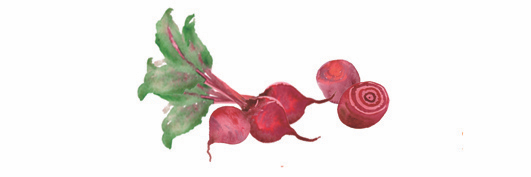
Our Favorite Produce Available in June
BEST JUNE VEGETABLES
BEETS
These little red gems can be divisive in the juicing world. Some people love their sweet taste, while others find them a little too earthy. Either way, they are packed with an array of nutrients including folate, potassium and magnesium.>7
• Shopping tip: When shopping for beets, look for plump, firm vegetables without any damage on their skin. Always look for beets with greens attached, as you get a bonus vegetable that you can steam, sauté or juice as well, similar to Swiss chard.
• Regrowing tip: Save one beet to regrow your beet greens. Use a shallow bowl with a bit of lip and add just enough water to cover the beet's cut end of the top. Wait a few days for new leaves to form and don’t forget to change your water frequently.
• Varieties: Look for red, white, gold, purple, or candy-stripe (red on outside, white and red swirl on the inside). Check out our Beet Berry Recipe (LINK) and use any variety you can find.
• Storage tip: Remove greens and stems (store separately), gently wash and dry your beets and store in your produce drawer for up to two weeks
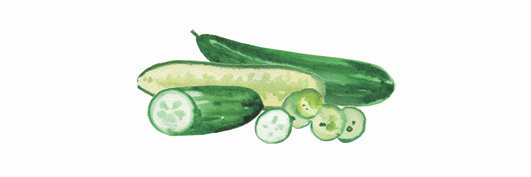
CUCUMBERS
These long green seedy vegetables are classified as fruit in the botanical world. Cucumbers always top the list of high-yield produce for juicers and add a sweet, mild flavor to any recipe. They are a great summer food for staying hydrated as you enjoy longer, more active days. This fresh food contains multiple B vitamins, including B1, B5 and B7 (biotin), along with quercetin and potassium.8
• Shopping tip: When shopping for cucumbers, always look for bright, firm ones without wrinkles or yellow spots, and know that smaller varieties tend to be crisper.
• Varieties: Look for pickling, slicing, Persian (also known as minis), or English.
• Storage tip: Keep cucumbers in a warmer section of the fridge, usually closer to the door, as cold temperatures can make them mushy. If picked fresh, they can last on the counter for a night or two without refrigeration. In the fridge, they can last up to a week.
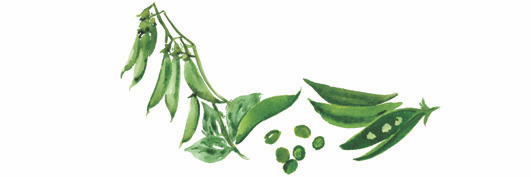
SUGAR SNAP PEAS
If nature had a fast-food snack, it would definitely be fresh sugar snap peas. They are great to crunch on in the summertime on their own or with a homemade dip. These peas offer many great nutrients including fiber, folic acid and vitamins A, C and K.9
• Shopping tip: Never buy snap peas that look floppy or spotted. If your farmer lets you sample one first, even better!
• Varieties: They are usually green but sometimes you can find purple ones too.
• Storage tip: Keep sugar snaps in a mesh or paper bag in your produce drawer for up to one week.

LETTUCES
Trying to eat more greens? Let lettuce help you achieve that goal. These green leafy vegetables are crisp and versatile. Use them as a base for salads and bowls, wraps and yes, in your juice. Plus, people who eat salad (a.k.a. lettuce greens) have been found to have higher intakes of nutrients like fiber, vitamins A, C and K and folate than those who don’t. [10]
• Shopping tip: Look for lettuce with vibrant green leaves in a tight head free from brown or yellow spots. If the head of lettuce seems loose, that’s a sign it could be more bitter or past its prime.
• Varieties: Try something new this summer, if you always go for Romaine or iceberg lettuce, try a green leaf lettuce, frisee or Boston variety.
• Storage tip: Lettuce greens will stay longer in your fridge when dry. If you wash them when you get home, be sure to dry them thoroughly before adding them to the produce drawer.
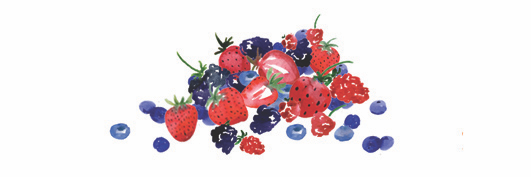
BEST JUNE FRUITS
BERRIES
June is the month to enjoy freshly picked berries, especially strawberries and raspberries. Loaded with antioxidants, fiber and vitamin C, they always top lists as one of the healthiest foods you can eat.10>/sub> Plus, they add sweetness to any juice, smoothie or sorbet.
Shopping tip: To prolong the not-very-long shelf life of berries, be sure to look for berries that have no sign of mold or bruising. Once one gets moldy, it passes on to the others quickly.
Varieties: Look for wild berries. Berries that grow wild in the woods tend to be smaller and sweeter. Cultivated berries tend to be larger and grown on farms.
Storage tip: Berries will stay fresher longer if you store them uncovered in the fridge (up to three days). While many people like to wash produce right after shopping, moisture will speed up their ability to grow mold, so wait to wash them just before eating or juicing. A great tip for washing berries is to empty a whole container into a bowl of water and let them soak for 5 minutes, then dry and enjoy!
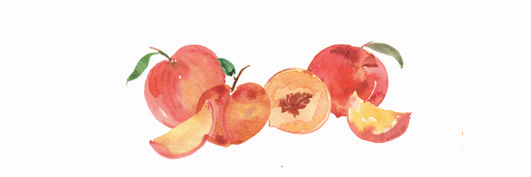
PEACHES
Alice Walker once wrote, “Life is better than death, I believe, if only because it is less boring, and because it has fresh peaches in it.” Stone fruits come into season in June and these golden, fuzzy fruits are sweet and delicious. The flesh of peaches is packed with vitamin C, polyphenols and carotenoids.11
• Shopping tip: When searching for peaches, let your nose lead. They should smell sweet and fragrant. You can also give them a gentle squeeze to make sure they are firm but still have a little give
• Varieties: Enjoy any and all of the yellow or white varieties.
• Storage tip: Peaches can last up to three days on your counter to ripen and then can be transferred to the fridge, where they should stay fresh for up to one week.
WILD JUNE FOODS TO FORAGE
Summer is a great time to get out in nature and see what’s growing. If you are new to foraging food, you can start by taking a class or joining a local meet-up with an experienced guide. Many local restaurants will include wild foods on their menu, which is another great way to sample nature’s plenty. If you’re already familiar with some of the wild plants in your area, then now is a great time to incorporate them into your meals.

HONEYSUCKLE
Honeysuckle is a beautiful, edible flower, whose fragrance may remind you of childhood summers. It blooms in late spring and early summer throughout much of the U.S. and Canada.
To harvest it, simply cut the blossoms from the vine and try to keep the nectar of the honeysuckle inside the flower.
You can turn it into tea by placing the flowers on wire trays and letting them sit in sunlight for a day to dry out. Once dry, place into an airtight container, such as a Mason jar, and store in a cool, dry place. You can also add the dried flowers to a honey or try adding the fresh flowers to a homemade ice cream or sorbet.
JUNEBERRY
This wild berry is also known as a saskatoon or serviceberry in some areas. They look much like a blueberry with a more reddish, purple tone, and they tend to be a bit softer.
These sweet-tasting berries are rich in antioxidants along with protein, calcium and iron.12 Look for them in mid to late June growing on small to midsize trees. You can add them to jams, pancakes, juices or sorbet.
LAMBS QUARTERS
I first discovered this wild green growing in my garden. It helped me realize the true definition of a weed, which is simply a plant in the wrong place. You could easily pick it out of the garden, but it’s free food that’s rich in calcium, vitamin A and potassium.13
Lambs quarters is related to quinoa and typically grows in gardens or well-fertilized pastures. The leaves are just like spinach in both texture and taste. You can use it as you would spinach by sauteing it or enjoying it raw in a salad or juice.
TIPS FOR SUMMER TRAVEL
Many of us take road trips or plan vacations during the summer months, and it can be challenging to keep your routines going when you travel.
Jacobs offered a few tips for finding fresh produce on summer trips.
“Find a local farmers market wherever you land,” she offered. “During the summer, farmers’ markets pop-up nearly everywhere, so chances are you'll be able to find one. It's also such a fun way to explore what a new city has to offer. While you're there grab some fresh berries or fruits and veggies that are easy to snack on like carrots and cucumbers. You'll also likely be able to find freshly made dips, such as hummus at the market, which you can enjoy with your veggies.”
If you are traveling via car, you can certainly pack your juicer with you—just remember to bring your cleaning brush along with your juice and pulp containers. I like to use a small suitcase just for the juicer and its accessories.
Or if you don’t want to pack your juicer, consider making some juices before you go and adding them to your snack bag or cooler. Juices are a great way to boost your energy on a long car trip and keep you hydrated. Plus consuming those extra fruits and veggies can be helpful, especially if you travel somewhere that has less healthy options.
THE JUNE TAKEAWAYS
5 INGREDIENTS TO JUICE RIGHT NOW
We know we mentioned quite a few ingredients to look out for already, but here’s a recap of the best fruits and veggies to juice this month:
• Beets: add sweetness and vibrant color to juices
• Berries: add a refreshing summer flavor (see our Beet Berry recipe for inspiration)
• Cucumbers: great for high-yield green juices
• Lettuces: Look for what’s fresh near you—red leaf, green leaf and butter lettuces all work great in juice
• Peaches: pair with sweet potato and apple for a dessert-style juice
JUICING TIP FROM OUR COMMUNITY
We asked our friend and partner, Lena from Pure Vegan Food, for her favorite juicing tips for the month of June.
What is your favorite juicing tip of the month?
Juice in bulk every morning, so you have chilled juice in your fridge available to enjoy and stay hydrated during summer days.
What’s your top summer juice ingredient?
Cucumbers are my favorite to make a hydrating juice, combined with basil or mint and a squeeze of lime. And of course, we juice pineapples daily! The kids love them with passion fruit and a hint of ginger.
sources:
- https://diabetesjournals.org/care/article/36/10/3262/30770/Three-15-min-Bouts-of-Moderate-Postmeal-Walking
- https://lillianjacobswellness.com/2021/08/11/rose-cardamom-cookies
- https://www.ncbi.nlm.nih.gov/pmc/articles/PMC3361919
- https://pubmed.ncbi.nlm.nih.gov/29406576
- https://pubmed.ncbi.nlm.nih.gov/17852499
- https://www.ams.usda.gov/local-food-directories/csas
- https://health.clevelandclinic.org/the-health-benefits-of-beets
- https://www.organicconsumers.org/news/9-health-benefits-cucumbers
- https://www.nutrition-and-you.com/snap-peas.html
- https://pubmed.ncbi.nlm.nih.gov/31278048
- https://pubmed.ncbi.nlm.nih.gov/26501271/
- https://health.clevelandclinic.org/benefits-of-peaches
- https://www.growingmagazine.com/guide-to-juneberries
- https://foodstruct.com/food/lambsquarters
- Choosing a selection results in a full page refresh.
- Press the space key then arrow keys to make a selection.


